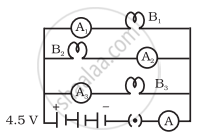Advertisements
Advertisements
प्रश्न
Compute the heat generated while transferring 96000 coulomb of charge in one hour through a potential difference of 50 V.
उत्तर
Given Charge, Q = 96000C
Time, t = 1hr = 60 x 60 = 3600s
Potential difference, V= 50volts
Now we know that H = VIt
So we have to calculate I first
As I = `Q/t`
∴ I = `96000/3600`
= `80/3A`
H = V × I × t
By substituting the values,
`50 xx 80/3 xx 60 xx 60`
= 4.8 × 106 J
Therefore, the heat generated is 4.8 × 106 J.
APPEARS IN
संबंधित प्रश्न
Why is the tungsten used almost exclusively for filament of electric lamps?
Name any two effects of electric current.
An electric heater is connected to the 230 V mains supply. A current of 8 A flows through the heater.
(b) How much energy is transferred to the heater each second?
Write down the formula for the heat produced when a current I is passed through a resistor R for time t.
Give scientific reason :
In the electric equipment producing heat e.g. iron, electric heater, boiler, toaster, etc., an alloy such as Nichrome is used, not pure metals.
Name any six domestic appliances based on the heating effect of electric current.
Answer the following question:
what is the heating effect of the electric current? state any four applications of it?
Solve the following question.
Compute the heat generated while transferring 96000 coulombs of charge in two hours through a potential difference of 40 V.
Live wire and neutral wires have a 220 V potential difference.
An electric kettle consumes 1 kW of electric power when operated at 220 V. A fuse wire of what rating must be used for it?
B1, B2 and B3 are three identical bulbs connected as shown in Figure. When all the three bulbs glow, a current of 3A is recorded by the ammeter A.
- What happens to the glow of the other two bulbs when the bulb B1 gets fused?
- What happens to the reading of A1, A2, A3 and A when the bulb B2 gets fused?
- How much power is dissipated in the circuit when all the three bulbs glow together?

Three incandescent bulbs of 100 W each are connected in series in an electric circuit. In another circuit another set of three bulbs of the same wattage are connected in parallel to the same source.
- Will the bulb in the two circuits glow with the same brightness? Justify your answer.
- Now let one bulb in both the circuits get fused. Will the rest of the bulbs continue to glow in each circuit? Give reason.
Can we use the same fuse in a geyser and a television set? Explain.
What are the uses of electromagnets?
What are the factors affecting heating effect of electric current?
______ wire is used in the filament of the bulbs.
A student boils water in an electric kettle for 20 minutes. Using the same mains supply he wants to reduce the boiling time of water. To do so should he increase or decrease the length of the heating element? Justify your answer.
An electrochemical cell converts ______ energy into ______ energy.
A trip switch is a ______ safety device.
